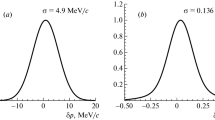Abstract
The leptonic branching ratios of the tau lepton have been determined from data collected by the OPAL detector in 1991 and 1992. From a sample of 27196 e+e−→τ+τ− candidates we find 7322\(\tau \to e\nu \bar \nu\) and 7941\(\tau \to \mu \nu \bar \nu\) candidates. Using efficiency and background estimates determined from a study of Monte Carlo events and control samples of data, the branching ratios\(B(\tau \to e\nu \bar \nu )\)=(18.14±0.20±0.28)% and\(B(\tau \to \mu \nu \bar \nu )\)=(17.48±0.18±0.23)% have been obtained. These new results have been combined with the published results for the 1990 OPAL data to yield the following branching ratios for data taken between 1990 and 1992:
These leptonic branching ratios are used with other properties of the muon and tau-lepton to test the universality of charged current leptonic couplings in these decays. The ratio\(R_\tau = B(\tau \to hadrons + \nu _\tau )/B(\tau \to e\bar \nu _e \nu _\tau )\) is calculated using our measured values of the leptonic branching fractions of the tau and tau lifetime from which a value of α s (Q 2=M 2τ ) is extracted. The value of α s (Q 2=M 2Z ) is obtained byQ 2 evolution and agrees with the value from the Z0 line shape analysis.
Similar content being viewed by others
References
The OPAL Collaboration, G. Alexander et al., Phys. Lett. B266 (1991) 201.
The OPAL Collaboration, K. Ahmet et al., Nucl. Instr. and Meth., A305 (1991) 275.
P. P. Allport et al., Nucl. Instr. and Meth., A324 (1993) 34.
J. Allison et al., Comp. Phys. Comm. 47 (1987) 55.
R. Brun et al., GEANT 3, Report DD/EE/84-1, CERN (1989).
D. R. Ward, in Proceedings of the MC'91 Workshop, NIKHEF, Amsterdam, 1991.
M. Arignon et al., Nucl. Instr. and Meth., A313 (1992) 103.
D. G. Charlton, F. Meijers, T. J. Smith, P. S. Wells, Nucl. Instr. and Meth., A325 (1993) 129.
M. Böhm, A. Denner and W. Hollik, Nucl. Phys. B304 (1988) 687; F. A. Berends, R. Kleiss, W. Hollik, Nucl. Phys. B304 (1988) 712; (BABAMC).
S. Jadach, B. F. L. Ward, and Z. Was, Comp. Phys. Comm. 66 (1991) 276; (KORALZ, Version 3.8).
T. Sjöstrand, Comp. Phys. Comm. 39 (1986) 347; (JETSET, Version 7.1).
R. Bhattacharya, J. Smith, G. Grammer, Phys. Rev. D15 (1977) 3267; J. Smith, J. A. M. Vermaseren, G. Grammer, Phys. Rev. D 15 (1977) 3280.
S. Jadach, J. H. Kühn, and Z. Was, Comp. Phys. Comm. 64 (1991) 275; (TAUOLA, Version 1.5).
L. Lyons, D. Gibaut and P. Clifford, Nucl. Instr. and Meth. A270 (1988) 110.
The CLEO collaboration, O. S. Akerib et al., Phys. Rev. Lett. 69 (1992) 3610.
‘Review of Particle Properties’, L. Montanet et al., Phys. Rev. D50 (1994) 1173.
The ALEPH collaboration, D. Decamp et al., Z. Phys. C54 (1992) 211.
W. J. Marciano, Ann. Rev. Nucl. Part. Sci. 41 (1991) 469.
W. J. Marciano and A. Sirlin, Phys. Rev. Lett. 61 (1988) 1815.
D. Britton et al., Phys. Rev. Lett. 68 (1992) 3000.
G. Czapek et al., Phys. Rev. Lett. 70 (1993) 17.
The OPAL Collaboration, R. Akers et al., Phys. Lett. B338 (1994) 497.
E. Braaten, S. Narison and A. Pich, Nucl. Phys. B373 (1992) 581 and references therein.
F. Le Diberder and A. Pich, Phys. Lett. 286B (1992) 147.
The OPAL collaboration, P. Acton et al., Z. Phys. C55 (1992) 1.
The ALEPH Collaboration, D. Buskulic et al., Phys. Lett. B307 (1993) 209.
T. N. Truong, Phys. Rev. D47, (1993) 3999.
M. A. Shifman, A. L. Vainstein and V. I. Zakharov, Nucl. Phys. B147 (1979) 385, 448, 519.
S. Narison, Phys. Lett. B300 (1993) 293.
G. Altarelli, Proceedings of the Third Workshop on Tau Lepton Physics, Montreux, (1994), CERN-TH 7493 (1994)
S. Narison, Proceedings of the Third Workshop on Tau Lepton Physics, Montreux, (1994), CERN-TH 7506 (1994)
G. Altarelli, P. Nason and G. Ridolphi, CERN-TH 7537 (1994).
W. Bernreuther and W. Wetzel, Nucl. Phys. B197 (1982) 228.
The LEP Collaborations, ALEPH DELPHI L3 OPAL, and LEP Electroweak working group, CERN-PPE 94-187 (1994)
The DELPHI collaboration, P. Abreu et al., Z. Phys. C55 (1992) 555.
The L3 collaboration, O. Adriani et al., Phys. Lett. B236 (1993) 1.
Author information
Authors and Affiliations
Consortia
Rights and permissions
About this article
Cite this article
OPAL Collaboration., Akers, R., Alexander, G. et al. Measurement of the leptonic branching ratios of the τ lepton. Z. Phys. C - Particles and Fields 66, 543–554 (1995). https://doi.org/10.1007/BF01579629
Received:
Issue Date:
DOI: https://doi.org/10.1007/BF01579629




